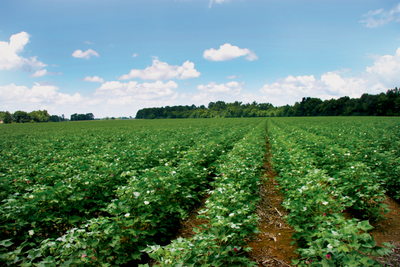
With rains that have measurably brightened the outlook for much of the cotton belt, heralding potential for a significantly larger than expected crop, prices may get worse before they get better, says O.A. Cleveland, Jr., veteran cotton analyst and Extension economics professor emeritus at Mississippi State University.

Things just haven’t been rosy, price-wise, for cotton — the December futures contract lost 10 cents in a recent 12-day period, and was down 9 of 10 days.
And with rains that have measurably brightened the outlook for much of the cotton belt, heralding potential for a significantly larger than expected crop, things may get worse before they get better, says O.A. Cleveland, Jr., veteran cotton analyst and Extension economics professor emeritus at Mississippi State University.

ALTHOUGH much of this year's cotton was planted late, rains — particularly in the key West Texas area — are pointing to a significantly larger crop than had been expected pre-Memorial Day.
“If I had to set a low for the December futures contract, I’d say 65 cents,” he said at the annual joint meeting of the Mississippi Boll Weevil Management Corporation and the Mississippi Farm Bureau Federation Cotton Policy Committee. “I’d see 62 cents as an absolute low.
“We had December cotton up to 86 cents, now we’re at 71 cents. I’m optimistic that we’ll stop price hemorrhaging at 68 cents to 70 cents, and I’d be extremely concerned now if we see 65-cent December futures. At 65 cents for December futures, Chinese textile mills can easily make money buying U.S. cotton. That should be all the market needs to stop the hemorrhaging.”
AG NEWS delivered daily to your inbox: Subscribe to Delta Farm Press Daily
Speculators, who have been long the last two years are backing out of the market, he says, and short-sellers will take their profits and move out.
“We will sell more cotton,” Cleveland says. “As the market moves lower, it will become extremely obvious that the Chinese will jump back in quickly and buy. They’ve been very price conscious during this price decline — we’ve not sold them much cotton.
“But there hasn’t been much of anyone’s cotton sold around the world. Textile mills have been operating hand-to-mouth as they watch the market fall. They’re not forward pricing; they’re watching to see what the market does.”
But, Cleveland says, a return to $1 cotton just isn’t in the cards.
“Even if there are crop troubles as the season goes on, or if West Texas should have rain problems at harvest, I think it would be difficult for the market to go beyond 73-74 cents, with an absolute top of 75 cents. I don’t see that — we’d have to get some horrible weather, and nobody’s going to be happy in that kind of scenario, because there won’t be much yield.”
Bullish on 2015 cotton
All isn’t gloom, however. “Just hold on — I’m very bullish for cotton in 2015,” Cleveland says.
China is again the dominant factor in that optimism. “They’re going to be dropping their production significantly,” he says, “and there’s pent-up demand that’s coming this year that’s associated with price.
“We’ve also got to consider the potential for bumper Midwest corn and soybean crops this year and the impact that will have on price. That will just overwhelm the market, and we’ll see more cotton being grown in the U.S. in 2015 because of the lower corn and soybean prices. I think cotton will be a much more favorable option in contrast to feed grains.”
What’s behind the recent market price gyrations?
“Initially,” Cleveland says, “we thought there was going to be a terrific squeeze on the July contract, that there would be a lot more people looking for cotton as that contract expired than there was cotton available, which cause the price to go up to $1 over July. That didn’t happen and the price came tumbling down.”
A major factor? Rain.
“For the last three years, the traditional Memorial Day rains didn’t come to the High Plains of Texas. This year, they came at the last minute, and they’ve had rain every week since then. That has caused the perception of the U.S. crop this year to increase from 13 million, maybe 14 million, perhaps as low as 12 million, bales we’d been expecting pre-Memorial Day.
“After the rains in Texas and everyone else finally got their weather-delayed crop in, we found ourselves looking at a crop of at least 17 million bales, with an outside chance of 18 million. I think 18 million is a little far-fetched, but it’s very early in the crop year, and with the right combination of circumstances it could happen. Or the other side of the coin, it could drop back to 13-14 million.
Still time for big crop
“But, the acreage is out there now. The crop is late, but we’ve still got a lot of time to make a cotton crop — look what happened with last year’s late crop, that produced record yields for Mississippi — with the potential for 2014 yields to be very high. Mississippi acreage was somewhat of a surprise, at 400,000, a significant increase from last year’s 280,000.
“Will we have a 17.5 million bale U.S. crop? USDA’s supply/demand report July 11 will offer a subjective look, but we won’t really have an objective look until their field survey the first of August.”
Cleveland says he is working on “the assumption that the Mid-South crop will catch up, that it will get the degree days it needs, and that the West Texas crop will get the rains it needs. The weather folks tell us now that the drought cycle and rain cycle have been broken in Texas, that they’re going to keep getting rain well past the harvest season, and that could make things somewhat touchy for them as they begin bringing in this crop.”
West Texas has become the leader for quality cotton produced in the U.S., he notes. “There is California’s Pima cotton, and Arizona’s Supima, but now the large block of middling/strict low middling is coming out Texas. That is the quality cotton the world wants. We’ve got varieties coming on that will help Mid-South growers with quality, but right now Texas is the leader.
“And quality cotton is what’s driving the market,” Cleveland says. “We’ve been very short of quality cotton, which is another reason the July contract was so strong. There’s a shortage of quality cotton worldwide, so we need for this U.S. crop to come off with high quality.”
About the Author(s)
You May Also Like



